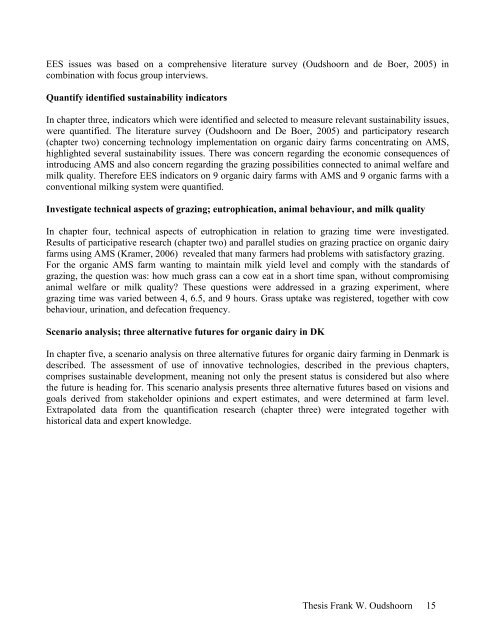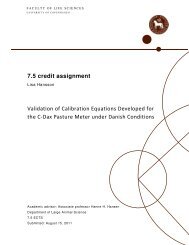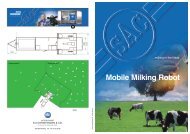Innovative Technology and Sustainable Development of Organic - 1.
Innovative Technology and Sustainable Development of Organic - 1.
Innovative Technology and Sustainable Development of Organic - 1.
Create successful ePaper yourself
Turn your PDF publications into a flip-book with our unique Google optimized e-Paper software.
EES issues was based on a comprehensive literature survey (Oudshoorn <strong>and</strong> de Boer, 2005) in<br />
combination with focus group interviews.<br />
Quantify identified sustainability indicators<br />
In chapter three, indicators which were identified <strong>and</strong> selected to measure relevant sustainability issues,<br />
were quantified. The literature survey (Oudshoorn <strong>and</strong> De Boer, 2005) <strong>and</strong> participatory research<br />
(chapter two) concerning technology implementation on organic dairy farms concentrating on AMS,<br />
highlighted several sustainability issues. There was concern regarding the economic consequences <strong>of</strong><br />
introducing AMS <strong>and</strong> also concern regarding the grazing possibilities connected to animal welfare <strong>and</strong><br />
milk quality. Therefore EES indicators on 9 organic dairy farms with AMS <strong>and</strong> 9 organic farms with a<br />
conventional milking system were quantified.<br />
Investigate technical aspects <strong>of</strong> grazing; eutrophication, animal behaviour, <strong>and</strong> milk quality<br />
In chapter four, technical aspects <strong>of</strong> eutrophication in relation to grazing time were investigated.<br />
Results <strong>of</strong> participative research (chapter two) <strong>and</strong> parallel studies on grazing practice on organic dairy<br />
farms using AMS (Kramer, 2006) revealed that many farmers had problems with satisfactory grazing.<br />
For the organic AMS farm wanting to maintain milk yield level <strong>and</strong> comply with the st<strong>and</strong>ards <strong>of</strong><br />
grazing, the question was: how much grass can a cow eat in a short time span, without compromising<br />
animal welfare or milk quality? These questions were addressed in a grazing experiment, where<br />
grazing time was varied between 4, 6.5, <strong>and</strong> 9 hours. Grass uptake was registered, together with cow<br />
behaviour, urination, <strong>and</strong> defecation frequency.<br />
Scenario analysis; three alternative futures for organic dairy in DK<br />
In chapter five, a scenario analysis on three alternative futures for organic dairy farming in Denmark is<br />
described. The assessment <strong>of</strong> use <strong>of</strong> innovative technologies, described in the previous chapters,<br />
comprises sustainable development, meaning not only the present status is considered but also where<br />
the future is heading for. This scenario analysis presents three alternative futures based on visions <strong>and</strong><br />
goals derived from stakeholder opinions <strong>and</strong> expert estimates, <strong>and</strong> were determined at farm level.<br />
Extrapolated data from the quantification research (chapter three) were integrated together with<br />
historical data <strong>and</strong> expert knowledge.<br />
Thesis Frank W. Oudshoorn 15




